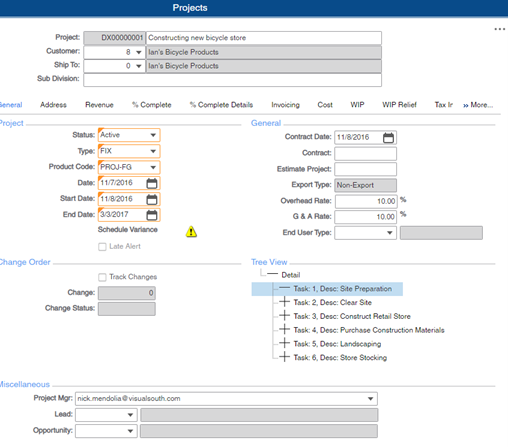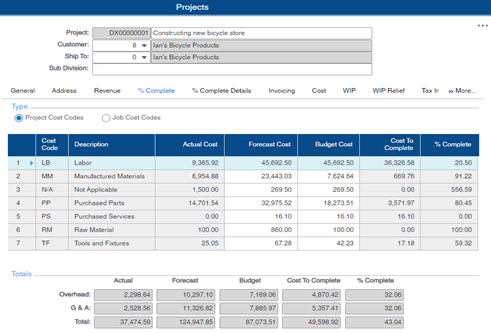Project-based manufacturers have specific ERP functional requirements
To effectively address business needs, project-based companies must choose an ERP system that meets their specific functional requirements. This is critical for success. The first step is to assess whether the ERP you’re evaluating offers project-related functionality at all, in addition to its standard functionality.
If the ERP doesn’t have project tools, then remove that system from consideration. If the ERP vendor must use a partner, network, or third-party application to accommodate project-based needs, eliminated them as well. You want to find an ERP system with built-in functionality to handle your company’s specific needs.
Typical project-based ERP systems should, at minimum, provide the following functional attributes:
- Project Structure for capturing project costs
- Percent Complete Revenue Recognition
- Milestone or Progress Billing
- Microsoft Project Integration for customer updates
Project structure
The ability to have project structure is highly important for manufacturers to have in their ERP systems, particularly for engineer-to-order and capital equipment-type manufacturers. For example, companies that design capital equipment to meet a specific need must have project-based ERP functionality. Other relevant examples of project-based companies include design-to-concept or design-to-print companies such as sign manufacturing companies or engineer-to-order manufacturers such as the crane manufacturing industry.
The manufacturing project built into the project-based ERP software needs to be able to accommodate and account for all activities in the project. For example, it must have the ability to create tasks to capture time for the engineering effort and budgeted hours in the project. The system should also track engineering costs and provide upstream visibility, allowing purchasing and manufacturing to set proper expectations for the release of the drawings and bill of materials. Purchased product costs should be captured to the project, whether it’s an R&D effort or purchasing raw materials to the project and project-specific warehouse.
The ERP system also needs to track other efforts as a task against the project, such as permitting customer approvals of items (drawings, renderings, and prototypes), and related documents.
All manufacturing jobs should be able to be tracked to a project as well. Software systems that don’t have project structure abilities use sub-assemblies tied to a single work order to try to accommodate this need, and it is not a satisfactory option. Vendors providing this workaround in lieu of true project-based tools should be eliminated.
 Infor CloudSuite Industrial ERP provides project-based manufacturers with tools to manage, track, and cost all project-related activities.
Infor CloudSuite Industrial ERP provides project-based manufacturers with tools to manage, track, and cost all project-related activities.
Other activities that may need to be accommodated by the project structure include transportation, sight prep, general contractor alignment, either internal resources for installation or partners, and post-installation training and programming.
Project costing
Project costing is another critical area you should evaluate. Ensure the ERP system has the ability and mechanisms to capture all project costs, including electronic time sheets and mobile shop floor systems for capturing labor, material issues, and quality inspections. The project-based ERP system should allow mobile devices to capture all service related costs and offer portals for vendors/partners to enter time for contracted service jobs.
Once costs are captured, the system should be able to readily provide you with actuals to budget, estimate at complete, and most importantly, percent complete revenue recognition. If percent complete revenue recognition and tracking of other project indices must be done outside the system (such as in Excel).

Project managers using Infor CloudSuite Industrial ERP can see all project costs as they occur, as well as percent complete, forecast to complete, and expected costs to complete.
Billing
Most ERP systems provide the ability to do milestone or progress billing, but ensure that billing, shipments, and percent complete revenue can all be disparate events in the ERP you choose. For instance, just because you are making a shipment, the ERP shouldn’t trigger either a payment or revenue recognition.
Microsoft Project integration
Microsoft Project two-way integration is typically needed. If you must use Microsoft Project to manage the project versus native project-based ERP functionality, then the ERP system is weak in this area. However, having the integration to Microsoft Project is most helpful when needing to provide customers updates on the progress of the project. Especially for those who have longer running projects where the duration is three months or longer.
Other considerations when evaluating project-based ERP software is to ensure it can support all the other business requirements, including Document Management, Planning and Scheduling, Quality, Service, and multi-site and multi-company abilities. Also, consider future-proofing your choice with regard to compliance. For example, many project-based manufacturers are in the Department of Defense supply chain and CMMC 2.0 compliancy may be required. Additionally, ensure that your project-based ERP system is FedRamp authorized and has a GovCloud option. Infor CloudSuite Industrial/SyteLine ERP is unique in the fact that it is FedRamp authorized and available in AWS GovCloud, and that is a key differentiator for those evaluating project-based ERP that are required to meet CMMC certification.
Summary
If you are having issues trying to manage the complex nature of non-integrated systems for projects, project manufacturing, service projects, project costing, and related project activities, and are considering evaluating ERP systems, please reach out for a free consultation. The team at Visual South will discuss options for improvement and how to address your business issues.








